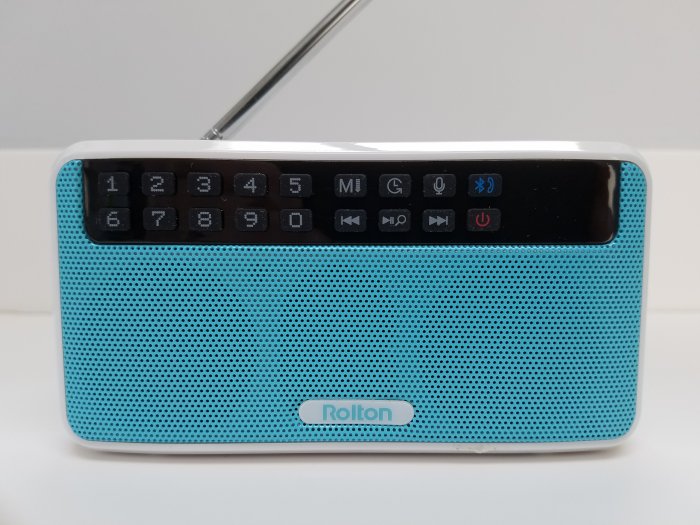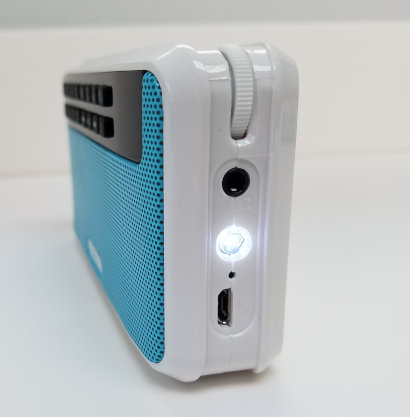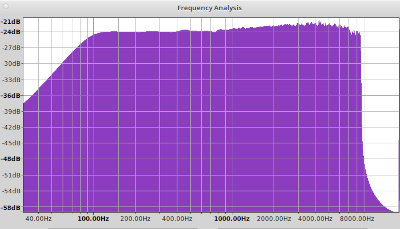
Starting in 2020, and even the year before, numerous speakers that connect to an audio source with the Bluetooth communications protocol appeared on Amazon. For the most part, these speakers are intended for use with cellphones and tablets, but they often include FM radios, and the ability to record and play back files from a micro-SD card. The Chinese radio-industrial complex cranked out these devices under a variety of brand names, at a typical retail cost (on Amazon) between $10 and $30.
The Rolton E500 is a good example of such a speaker. I paid a little over $20 for it at Amazon in 2020. It's not just another black or gray box. The case is white, with the front speaker grille available in one of four colors: green, purple, yellow, or blue. As you can see from the photo above, I got the blue version.
The unit is composed of three speakers: two speakers (left channel and right channel) plus a woofer. The audio amplifier has an output power of up to three watts, impressive for a unit of such a small size.
Almost all controls are on the front panel above the speakers. There is a telescoping FM antenna on the top of the E500. As usual for products of the Chinese radio-industrial complex, it's too short: 10 inches instead of 30.
The device has various modes corresponding to its capabilities:- Connecting via Bluetooth to an audio source
- Connecting via Bluetooth to a cellphone, using the device as a speakerphone
- Connection to a computer with a USB cable, using the device as an auxiliary speaker for the computer
- Playback of music files from a micro-SD card
- Listening to FM radio
- Recording from the built-in microphone, the FM radio, or a phone call
When you first turn on the Rolton E500, or when you change modes, a synthesized voice announces the mode that the unit is functioning in.
The Rolton E500 also has an LED flashlight!

On the top of the unit, there's a slot for a micro-SD card, the button to turn the flashlight on and off, and a thumbwheel volume control. On the right side of the unit (shown at left) is a standard headphone jack for stereo headphones; the LED flashlight, turned on in this picture; and a micro-USB port for connectivity or charging.
The Rolton E500 uses a rechargeable lithium-ion battery that is not removable. Therefore, the device is useable only as long as the battery continues to function.
It's important to read the owner's manual that comes with the E500. The device often does not work the way you would expect a radio, or even a Bluetooth speaker, to work.
The M button on the front of the unit selects among the modes. In other words, M does not stand for "memory".
That said, the radio can memorize stations with an automatic scan. A long press of the button with the "pause" and magnifying-glass (for search) icons starts the station scanning function. Unfortunately, it finds stations erratically and sometimes finds interference that it shouldn't be stopping on. For example, one scan totally missed powerful, local San Francisco stations such as KOIT and KRBQ, but found six false signals below 88 MHz. Note that the FM radio can tune from 76 to 108 MHz, incorporating both the frequency range used worldwide as well as the Japanese band from 76 to 90 MHz.
I haven't compared the Rolton's radio with other models, but my general impression is that it is a modest performer at best, most similar to the Tivdio V-115's FM performance. It is probably not a DSP-based radio; at least it doesn't claim to be.
With the numeric buttons labeled from 1 to 0, it's also possible to enter the frequency of the desired station directly, e.g. 96.5 for KOIT and 102.1 for KRBQ. So it's possible to overcome the deficiencies in the unit's scanning capabilities.
Direct numeric entry can also be used with the music player. In order to make effective use of that capability, you'll have to know how the audio files are arranged on the micro-SD card that's inserted into the E500. I think that's unlikely. There are "back" and "forward" buttons that can also be used to navigate through the audio files. As unfortunately seems typical for these types of units, it only supports the MP3, WAV, and WMA formats - no open-source format or formats with lossless compression are supported.
The unit can be used as a speaker when plugged into a computer or anything else that outputs audio through a USB port. On a computer, this also mounts the E500 as an external disk drive.
I haven't used the E500's capabilities with a cellphone, so I won't address them here.

With a micro-SD card in the unit, the E500 can also make recording. What it records depends on the mode the unit is in. If it's in radio mode, then pressing the button with the microphone icon records the station that the radio is tuned to. If connected to a cellphone, the device records the phone call. There is also a "record" mode that makes a recording from the E500's built-in microphone.
While these seem to be handy capabilities for making recordings, there's a major drawback.
As with the Tivdio V-115 and the Tecsun ICR-100, there's a "brickwall" low-pass filter that sharply restricts the ability to record higher frequencies. Of all the brickwall filters I've encountered in these reviews (as of October 2020), the filter in the Rolton E500 is the most limiting. A frequency sweep (right) using a small FM transmitter shows a cutoff at 8.5 kHz. FM radio is capable of frequency response up to 15 kHz. As with the other devices that have built-in recording capability, there's no conceivable reason for setting the frequency cutoff so low.
Also odd is the rolloff in low-frequency response, starting at 100 Hz, and being down 12 dB at 40 Hz. This is not nearly as sharp a cutoff as the brickwall filter, but some listeners may still notice it.
The sampling rate for MP3 recordings made by the Rolton unit is 32 kHz, which places an effective ceiling of 16 kHz on frequency response anyway. One note: some programs will complain that files created by the E500 are not standard. Still, I have had no trouble playing them, at least on a computer.
The selling point for the Rolton E500 is the sound from its speakers. While good stereo separation is difficult to obtain due to the speakers being close together, the E500 has a very beefy sound, much bigger than you'd expect from speakers that size. Using the Rolton E500 as a Bluetooth or computer speaker would be the best use for the device. The radio, media playback, and recording features are nice addons but have some definite limitations. One could make the argument, as with the Tivdio V-115, that a device this inexpensive is going to have some flaws. The speaker system is the winner here; the rest so-so.